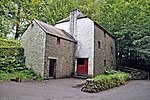Gwalia Stores

Gwalia Stores is a retail premises originally built at Ogmore Vale, Glamorgan, in 1880 and currently located at St Fagans National History Museum, Cardiff, Wales. The stores were a family business, run by William Llewellyn and his family. By 1916 the departments included bakery, ironmongery, grocery, men's outfitters, pharmacy and animal feeds. Some of the stores' employees also lodged on the premises. "Gwalia Stores" was a popular name for grocery stores in Wales during the early 20th century, and other shops with the same or similar names, unconnected to the one at St Fagans, can still be found. The stores closed for business in Ogmore Vale in 1973 and reopened at St Fagans in 1991. Part of the shop is still a retail premises; the rest of the ground floor is set up as it would have been during the 1920s. The first floor contains a tearoom.
Excerpt from the Wikipedia article Gwalia Stores (License: CC BY-SA 3.0, Authors, Images).Gwalia Stores
Valeways Millenium Heritage Trail, Cardiff St Fagans
Geographical coordinates (GPS) Address Website Nearby Places Show on map
Geographical coordinates (GPS)
| Latitude | Longitude |
|---|---|
| N 51.48786 ° | E -3.2778 ° |
Address
St Fagans National Museum of History
Valeways Millenium Heritage Trail
CF5 6XB Cardiff, St Fagans
Wales, United Kingdom
Open on Google Maps









